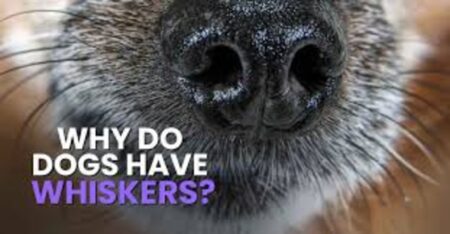
Why Do Dogs Have Whiskers? The Answer Revealed!
Have you ever wondered about those long, stiff hairs sprouting from your furry friend’s muzzle, eyebrows, and chin? Well, these peculiar strands, known as whiskers, serve various purposes for dogs beyond mere aesthetics.
Whiskers, or vibrissae, are specialized hairs that are deeply rooted in the skin and connected to the nervous system. These remarkable hairs are not only longer and thicker than regular dog hair but also more sensitive. According to VCA Animal Hospitals, whiskers are radar sensors!
Whiskers are an intriguing feature of a dog’s anatomy, often leading many to wonder about their purpose. As it turns out, whiskers serve various important functions that offer dogs an extra sense, which helps them navigate their environment.
Read on to discover the reasons why dogs have whiskers, the effect of cutting a dog’s whiskers, and the difference between a dog’s and a cat’s whiskers.
What is A Whisker?
A whisker, also known as vibrissae, is a long, thick, and highly sensitive hair found on the muzzle, eyebrows, and chin of dogs and other mammals. Unlike regular hair, whiskers are deeply rooted in the skin and connected to the nervous system, providing sensory information about the environment to the animal.
Whiskers serve multiple purposes, such as helping dogs navigate through space, sense changes in air currents, and detect nearby objects, essentially acting as additional “feelers” for the animal.
What Are Dog Whiskers Made Of?
Dog whiskers, also known as vibrissae, are made of keratin, the same protein that makes up human hair and nails but, unlike regular dog hair, whiskers are thicker, longer, and more deeply rooted in the skin. The base of the whisker is connected to nerve endings that make them highly sensitive and capable of transmitting sensory information to the dog’s brain. This unique structure allows dogs to use their whiskers as an additional sense to help navigate their environment and detect subtle changes.
Why Do Dogs Have Whiskers On Their Cheeks?
Dogs have whiskers on their cheeks to help them sense their surroundings and detect changes in their environment, and these cheek whiskers, known as mystacial vibrissae, are connected to sensitive nerve endings that allow dogs to pick up on subtle shifts in air currents and locate objects close to their face, even in the dark. So, by having whiskers on their cheeks, dogs can navigate their environment more effectively and avoid potential hazards. Aside from that, whiskers help a dog communicate, as they can help convey a dog’s emotional state or intentions to other dogs and humans.
Why Do Dogs Have Whiskers?
Below are ten (10) reasons why dogs have whiskers:
- Sensory perception: Whiskers help dogs gather information about their surroundings by detecting changes in air currents and nearby objects.
- Spatial awareness: Whiskers assist dogs in navigating through spaces, especially in the dark or tight spots.
- Protection: Whiskers can act as a buffer, alerting dogs to potential hazards and preventing facial injuries.
- Communication: The position and movement of whiskers can help communicate a dog’s emotions and intentions to other dogs and humans.
- Texture detection: Whiskers enable dogs to sense the texture of surfaces, which is useful when exploring new environments.
- Prey detection: In the wild, whiskers help dogs locate prey, as they can sense small changes in air currents caused by movement.
- Facial expression: Whiskers contribute to a dog’s facial expressions, making it easier to read their emotions.
- Balance and coordination: Whiskers can help dogs maintain balance, especially when they are walking on uneven terrain or in low-light conditions.
- Hunting and tracking: Whiskers assist dogs in tracking scents and locating hidden objects or animals.
- Natural adaptation: Whiskers are a natural feature that has evolved to aid in a dog’s survival and adaptation to various environments.
What Happens If You Cut Off A Dog’s Whiskers?
If you cut off a dog’s whiskers, it can cause several negative effects on their sensory perception, balance, and ability to navigate their surroundings. Whiskers are deeply rooted in a dog’s skin and connected to nerve endings, which allow them to gather vital information about their environment.
Cutting a dog’s whiskers can result in:
- Disorientation: Dogs may become disoriented, as whiskers help them maintain spatial awareness.
- Confusion: They may have difficulty judging distances and locating objects close to their face.
- Stress and anxiety: Whiskers also play a role in a dog’s emotional state, and removing them can cause stress or anxiety.
- Reduced sensory input: Whiskers help dogs detect changes in air currents and surface textures, so removing them impairs their sensory perception.
So, it is important to avoid cutting or trimming a dog’s whiskers, as they serve an essential function in their daily life and overall well-being.
Do Dogs Whiskers Grow Back?
Yes, dogs’ whiskers do grow back if they are accidentally cut or fall out. Like regular hair, whiskers grow from hair follicles, and these follicles will continue to produce new whiskers over time. However, the regrowth process can be slow, taking several weeks or even months for the whiskers to reach their full length and sensitivity. Therefore, it’s crucial to be careful and avoid cutting or damaging your dog’s whiskers to maintain their sensory abilities and overall well-being.
Why Do Cats Have Whiskers?
Cats have whiskers for several important reasons related to their sensory perception, hunting abilities, and communication. Here are five key reasons why cats have whiskers:
- Spatial awareness: Whiskers help cats navigate their environment by detecting changes in air currents and nearby objects. This is particularly useful in low-light conditions or when exploring tight spaces.
- Prey detection: Whiskers are highly sensitive and can detect subtle movements, enabling cats to locate and capture prey, especially at night when visibility is limited.
- Texture detection: Whiskers allow cats to sense the texture of surfaces and objects, helping them determine if something is safe to interact with or not.
- Balance and coordination: Whiskers provide cats with information about their body position, which helps them maintain balance and coordination when jumping, climbing, or walking on narrow surfaces.
- Communication: Whiskers play a role in feline body language and communication. For example, if a cat’s whiskers are pulled back against their face, it may indicate fear or aggression, while relaxed whiskers can signal contentment.
Dog Whiskers vs Cat Whiskers
Dog whiskers and cat whiskers have some similarities in function, but there are also notable differences in structure and sensitivity. Below is a detailed comparison between the two:
- Structure: Both dog and cat whiskers are made of keratin and are longer and thicker than regular hair. However, cat whiskers are usually more slender and tapered, while dog whiskers tend to be slightly coarser and may have a curve or bend.
- Sensitivity: Cats’ whiskers are more sensitive compared to dogs’ whiskers due to their unique structure and higher concentration of nerve endings.
- Purpose: Both animals use whiskers for sensory perception, spatial awareness, and communication. However, cats heavily rely on their whiskers for hunting, especially at night. Dogs, on the other hand, may use their whiskers for locating prey, but to a lesser extent than cats.
- Location: Cats have whiskers on their muzzle, above their eyes, on their cheeks, and even on their legs, whereas dogs mainly have whiskers on their muzzle, eyebrows, and chin.
- Growth and shedding: Both dog and cat whiskers grow continuously and are shed occasionally. However, the growth rate may vary between species.
So, while dog and cat whiskers have similarities in function, their unique structures and sensitivity levels reflect their specific adaptations for each species’ behaviors and needs.
Conclusion
In summary, dog whiskers serve multiple essential purposes like sensory perception, spatial awareness, balance, and communication, and these highly specialized hairs are deeply rooted in the skin and connected to nerve endings, allowing dogs to gather vital information about their environment and make informed decisions.
So, understanding the function of whiskers is crucial for dog owners, as it highlights the importance of preserving these delicate hairs to maintain a dog’s overall well-being. With proper care and attention, you can help ensure your furry companion’s whiskers remain healthy and functional, allowing them to navigate the world with confidence and ease.
FAQs
Q. Can you cut dog whiskers?
While it is technically possible to cut dog whiskers, it is not recommended. Whiskers serve an essential function in a dog’s sensory perception and ability to navigate their environment.
Q. Why do dogs have whiskers above their eyes?
Dogs have whiskers above their eyes, also known as supraorbital whiskers, to help them sense potential hazards or objects close to their eyes.
Q. What is the purpose of a dog’s whiskers?
The primary purpose of a dog’s whiskers is to enhance their sensory perception and gather information about their environment.
Q. Do dogs like having their whiskers touched?
Most dogs generally do not like having their whiskers touched, as it can be uncomfortable or even painful due to the sensitivity of the nerve endings connected to them.
Q. Can a dog walk without whiskers?
Yes, a dog can still walk without whiskers. However, their ability to navigate and sense their surroundings may be impaired, especially in low-light conditions or when navigating tight spaces.

